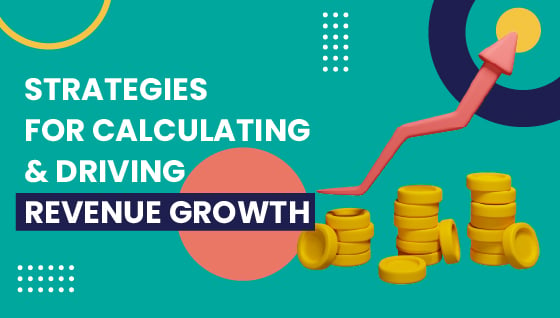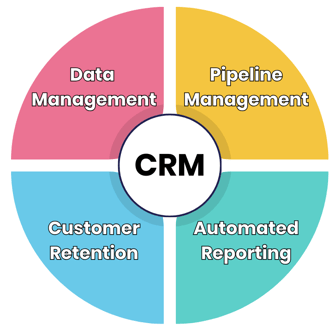


Strategies for Calculating & Driving Revenue Growth




Understanding and calculating revenue growth is a critical aspect of successful business operations. This indicator provides a benchmark for the financial health and prosperity of a business, supporting strategic decision-making and future planning.
By effectively measuring revenue growth, businesses can pinpoint areas for potential incremental change in each operation affecting their people, processes, and technology, which could drive further increases in revenue.
As Revenue Operations (RevOps) gains more importance day by day, having a deep understanding of these growth metrics is absolutely crucial. By implementing RevOps solutions, businesses can gain invaluable insights into potential areas of opportunity, fostering an environment of growth and sustained financial health.
In this article we'll dive deeper in the realm of revenue growth, how to calculate it, and why is it important to track your business' revenue growth.
Revenue Growth
Revenue growth is not just a number on a spreadsheet—it's the pulse of your business, indicating its ability to expand, thrive, and achieve financial objectives.
From a Revenue Operations (RevOps) standpoint, the measurement of revenue growth is not just a financial metric but a strategic imperative that aligns sales, marketing, and customer success functions toward a unified goal.
Revenue growth refers to the percentage increase in a company's total revenue over a specified period. Revenue Growth serves as a key performance indicator (KPI) that gauges a business's ability to generate more income over time. Calculated periodically, revenue growth reflects the effectiveness of a company's sales and marketing strategies, customer retention efforts, and overall business performance.
Why Do You Need To Calculate Revenue Growth?
Without a clear sense of your revenue growth, guiding your business can become unpredictable and unfocused.
Calculating revenue growth is not only important for providing a clear vision, but it also allows you to operate efficiently and become a leader in your industry. By understanding and tracking your revenue growth, you can identify areas of improvement and adjust your strategies accordingly.
Here are some other ways in which keeping a track of your revenue growth can prove helpful to your business:
1. Holistic Alignment of Departments
RevOps is about breaking down silos between sales, marketing, and customer success to create a unified revenue team. By sharing this essential metric, every team, from marketing to sales to customer service, can work cohesively towards the same goal - driving revenue growth.
2. Data-Driven Decision Making
RevOps relies on accurate and real-time data to make informed decisions. Measuring revenue growth provides the data needed to understand what is working and what needs improvement across the entire customer lifecycle. With accurate revenue growth figures at hand, businesses can make strategic decisions grounded in facts rather than relying on gut feelings or assumptions
3. Identify Trends & Predict Future Performance
By carefully comparing revenue figures across different periods, businesses can gain deeper insights into patterns and fluctuations, such as seasonal variations, which can greatly influence strategic decision-making. This comprehensive understanding of revenue dynamics empowers businesses to make informed choices and stay ahead of the competition.
4. Enhancing Customer Experience
Optimise by carefully assessing and analysing which specific products, services, or strategies are effectively contributing to business growth, companies can gain valuable insights to further refine and optimise their offerings. This enables them to better align with and exceed customer expectations, ultimately establishing stronger relationships and achieving sustainable success in the market.
5. Identifying Revenue Leakage Points
RevOps professionals scrutinise the entire revenue cycle to identify and rectify any points of revenue leakage. Whether it's inefficiencies in the sales process, gaps in marketing strategies, or challenges in customer onboarding, measuring revenue growth helps pinpoint areas for improvement.
6. Adapting to Market Changes
Markets are dynamic, and customer preferences evolve. Revenue growth measurement allows businesses to adapt to market changes, pivot strategies, and capitalise on emerging opportunities swiftly.
7. Facilitating Scalability
Sustainable revenue growth is a precursor to scalability. By understanding the rate at which revenue is growing, businesses can predict future growth and scale their operations accordingly, ensuring they're ready to meet increased demand without compromising on quality or customer satisfaction.
How to Calculate Revenue Growth?
%20Revenue%20in%20previous%20period-2.png?width=800&height=400&name=(Revenue%20in%20current%20period%20-%20previous%20period)%20Revenue%20in%20previous%20period-2.png)
Calculating revenue growth is a relatively straightforward process. The formula for it is as follows:
(Revenue in current period - Revenue in previous period) / Revenue in previous period x 100 = Revenue Growth Percentage
For example, if your business had revenue of £50,000 in the first quarter of this year and £45,000 in the first quarter of last year, your revenue growth would be:
(£50,000 - £45,000) / £45,000 x 100 = 11.1%
This calculation gives you a percentage that represents your business's revenue growth from one period to another. It is essential to perform this calculation regularly and track your results over time for a better understanding of your business's health and potential for growth.
Factors To Consider When Calculating Revenue Growth
While the formula seems fairly simple, calculating revenue growth isn't as easy. There are various factors you need to consider when calculating revenue growth that can impact the numbers. While you may not be able to control external factors such as the economy, market fluctuations, government regulations, etc.; analysing the following internal factors can help you make data-driven decisions to drive revenue growth:
- Product changes
- New hires or employee turnover
- Change in sales or marketing strategy
- Change in tech stack
- Operational efficiency
Role of CRM

CRM (Customer Relationship Management) plays a pivotal role in calculating revenue growth. It allows companies to monitor, manage, and analyse customer interactions throughout the customer lifecycle, fuelling the engine of revenue growth.
- Data Consolidation: CRM systems centralise customer data from various touch points, ensuring that RevOps teams have a holistic view of customers. This enables a more accurate calculation of revenue growth and projection of future trends.
- Sales Pipeline Management: By tracking leads, prospects, and customers, CRM systems offer invaluable insights into sales funnels. These insights can help RevOps teams identify bottlenecks and opportunities, thereby directly impacting revenue growth.
- Customer Retention: CRM systems help in nurturing relationships with existing customers, which is crucial for recurring revenue. A well-maintained relationship often results in customer loyalty, repeat purchases, and referrals - all of which contribute to revenue growth.
- Automated Reporting: With automated reporting features, CRM systems eliminate manual data processing, resulting in more accurate revenue growth calculations and more time for RevOps teams to focus on strategic activities.
In essence, a CRM system is like a compass guiding a ship; without it, your RevOps might lose direction. It not only helps in calculating revenue growth but is instrumental in shaping strategies that ensure your RevOps health. Whether you're charting a course for new revenue opportunities or navigating the complexities of customer retention, your CRM is the invaluable tool that keeps you on course.
Scope of growth: RevOps Solutions
Revenue growth remains a primary barometer of success in an organisation, but how to ensure this growth is not only sustained but also accelerated?
This is where RevOps comes into play.
RevOps, in essence, is the consolidation of operations across marketing, sales, and customer service aimed at driving revenue growth. By aligning these functions, RevOps can effectively bridge silos, ensuring a seamless customer experience, and ultimately, a healthy bottom line.
Implementing Revenue Operations (RevOps) within a company can have several positive effects on revenue growth. Here are key impacts that RevOps can have:
1. Improved Cross-Functional Collaboration
RevOps breaks down silos between sales, marketing, and customer success teams, fostering better communication and collaboration. Enhanced collaboration ensures a unified approach to revenue-generating activities, leading to more efficient and effective strategies.
2. Enhanced Customer Experience
RevOps aligns customer touchpoints across departments, creating a seamless and consistent experience. A positive customer experience leads to increased customer satisfaction, loyalty, and repeat business, ultimately contributing to revenue growth.
3. Optimised Sales Processes
RevOps evaluates and streamlines sales processes, eliminating inefficiencies and bottlenecks. Streamlined sales processes lead to faster deal closures, improved conversion rates, and a more agile response to market opportunities.
4. Unified Data Management
RevOps emphasises the importance of unified and accurate data across departments. Centralised and accurate data enables better decision-making, personalised customer interactions, and more effective revenue-driving strategies.
5. Data-Driven Decision Making
RevOps relies on data analytics to inform strategic decisions. Data-driven decisions allow businesses to allocate resources effectively, identify growth opportunities, and optimise strategies for maximum impact.
6. Aligned Technology Stack
RevOps ensures that the technology stack is aligned with business goals. A well-integrated tech stack enhances efficiency, improves collaboration, and provides a foundation for scalable revenue growth.
7. Optimised Customer Lifecycle Management
RevOps takes a comprehensive approach to managing the entire customer lifecycle. Effective customer lifecycle management ensures that revenue opportunities are maximised at every stage, leading to sustained growth and increased customer lifetime value.
8. Efficient Resource Allocation
RevOps helps in identifying areas where resources can be allocated more efficiently. Efficient resource allocation ensures that teams are focused on high-impact activities, contributing to overall revenue growth.
RevOps Assessment
Embarking on the journey of revenue growth without a RevOps health check is like setting sail in rough seas without a compass.
Conducting a comprehensive health assessment is crucial to evaluate your RevOps expertise, reveal valuable insights, and set the course for success. It's a diagnostic instrument that offers a thorough analysis of your RevOps progress. Based on this, you can delve into detailed analysis and implement actionable recommendations.
A comprehensive RevOps assessment can provide several key benefits. For one, it allows you to identify and address operational inefficiencies that could be stifling your growth. More importantly, it offers insights into how your marketing, sales, and customer service functions are working together (or not) to drive revenue.
A RevOps health check also sets the stage for future growth. By providing a clear picture of your current operations, it enables you to devise effective strategies for improvement. Whether that's investing in new technology, implementing better training programmes, or refining your customer retention strategies, a health check ensures your RevOps is ready to take on the challenges of revenue growth.
In essence, it's important to gain a better understanding of where you are in order to achieve the success you envision!
Take the RevOps Assessment right away, and get actionable insights and recommendations to set the stage for your company's success.








